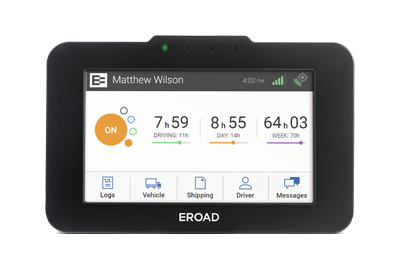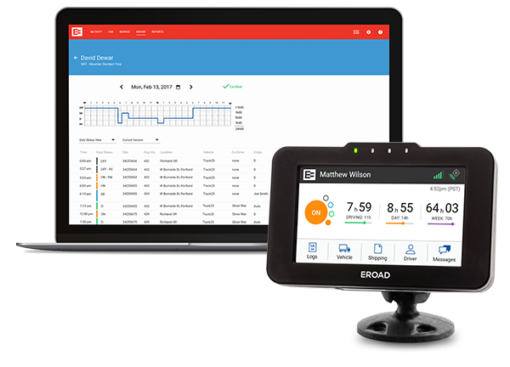Understanding ELD Compliance
In 2016, the electronic logging device (ELD) mandate began its first phase. Since then, several methods for logging hours of service (HOS) and commercial motor vehicle data have been phased out. As of December 16, 2019, ELDs are required by Federal Motor Carrier Safety Administration (FMCSA) across the industry.
Failing to keep up with ELD compliance will result in costly penalties. This guide is a look at the major components of the mandate, and what you can do to ensure that your fleet is ELD compliant.

What is ELD compliance?
ELD Compliance means installing and properly using an FMCSA-registered ELD to record hours-of-service in required vehicles. The following vehicles are subject to the mandate:
- Interstate CMVs where drivers are currently required to keep record of duty status
- Vehicles that weight 10,001 pounds or more
- Vehicles with placrded hazmat loads
The advent of ELDs hasn’t changed the rules for HOS, but it has changed the way drivers record their hours. HOS rules and records of duty status (RODS) requirements fall under 49 CFR Part 395. At a minimum, drivers need to keep RODS when they report for a shift, when they end a shift and how much actual driving took place during a shift. The ELD mandate added a new Appendix to Part 395 with all the technical requirements that a compliant ELD must satisfy. Hundreds of pages exist to explain FMCSA ELD compliance requirements.
The raw ELD mandate digs deep into the history of hours-of-service logging. It also covers the legal process the FMCSA and US Department of Transportation went through to approve the mandate, to where we are today.
Related: What is an ELD?
Key points from the history of the ELD Mandate
- 2012: Congress enacts a bill called “Moving Ahead for Progress in the 21st Century” (MAP-21) aimed at improving CMV safety
- 2016: The “awareness” phase allows fleets to transition from paper to AOBRDs or ELDs, without penalty, from Feb ‘16 to Dec ‘17
- 2017: AOBRDs installed by December 18th may still be used until the full compliance date
- 2018: Starting April 1st, hard enforcement of penalties for fleets that are not ELD compliant
- 2019: Full ELD compliance required by December 16, 2019
The bill in Congress came up after a court vacated requirements for electronic onboard recording devices (EOBRDs). While EOBRDs first gained traction in the early 2000s, and while AOBRDs have been around since 1988, several loopholes and limited compliance made it easy to skirt the rules.
In almost 30 years since electronic logging first arrived, many changes have come and gone. The general idea is that a device will be faster and more accurate than HOS paper logs. The mandate serves to enforce safe driving habits, instead of having a driver falsifying their logs and driving well into overtime.
Failure to remain in compliance can result in penalties, drivers out-of-service and reputation damage. Enforcement has steadily increased since ELDs were introduced, and added lenience is not likely down the road.
Exceptions to the ELD Mandate
Most of the more than 3.5 million CMV drivers across the nation are required to follow the mandate. There are some exceptions:
- Drivers who are not currently required to keep RODS
- Drivers subject to short-haul exemption and does not exceed criteria more than 8 days in a 30-day period
- Drivers conducting a drive-away-tow-away operation, in which an empty or unladen motor vehicle with one or more sets of wheels on the surface of the roadway is being transported, if the vehicle being driven is the commodity delivered, or if the vehicle being transported is a motorhome or RV.
- Drivers of vehicles with engines manufactured prior to model year 2000.
Understanding ELD compliance requirements
To be compliant, an ELD must be on the FMCSA’s ELD registry. That list also shows revoked devices, so be sure to check closely before ordering your ELDs.
Any drivers or carrier that is not using devices on the approved list, or whom cannot show/transfer data from an ELD when prompted, will be found to have “no record of duty status.”
That language comes from the Commercial Vehicle Safety Alliance’s update to out-of-service criteria. These changes, as outlined in a March 2019 letter, are mostly updates to specifically address ELDs, not overhaul the concept of being out-of-service.
There are many approaches to getting current with ELD compliance requirements. As a bare minimum, it is a requirement to make sure the following materials are included:

The ELDs on the FMCSA’s registry does not guarantee your compliance. You must tread carefully. Devices that do not meet FMCSA’s requirements could cause problems, from civil penalties to an audit of your whole fleet. Title 49, section 521 details that a driver or carrier could face civil penalties from $1,000 to $10,000 per offense.
Confident ELD providers undertake third-party certification to validate compliance. While it is not required, independent testing can go a long way. The credibility of an unbiased report shows that a particular ELD provider is willing to back up their solution.
The FMCSA requires all devices do the following:
- Connect to the engine and record its motion
- Provide secure transfer of data to enforcement (via web services and email; or USB and Bluetooth)
- Display RODS in a clear manner outside the vehicle
- Allow the driver to log in and select duty statuses
What are the key technical features of an ELD?
The Final Rule sets out details of the technical standards and functional specifications for an ELD to be considered compliant and eligible for self-certification and registration on the FMCSA website.
The ELD must support:
- Automatic capture of records at certain intervals from connecting to the vehicle: e.g. date, time, location, engine power status, engine hours, miles driven and motion status
- Personal Use and Yard Use are recorded against driving events if carrier authorizes the driver to use the special driving categories.
- Annotations and edits to ELD records to be permissible for drivers and carriers. However, original records cannot be overwritten and must be retained along with the edited versions.
- Detection of malfunctions with internal audit controls built into the system to notify data inconsistencies and system failures.
- Data transfer to enforcement officials to view on eRODS by either a telematics option (wireless web services and email); or local option (Bluetooth and USB).
- Driver HOS Graph Grid display to be available for the enforcement official without entering the vehicle, as backup to data transfer capability.
How does ELD compliance affect my fleet?
The good news? Despite big changes, ELD compliance is making life a lot easier for drivers and fleet managers. You can quickly manage the hours your drivers are behind the wheel to avoid unsafe and fatigued driving. More data and insight on driver activity can help fleets operate safer on the roads.
Cost is another factor. Consider how many work hours went into old pencil-and-paper logging and reporting. Dispatch is able to more efficiently plan routes, as well. These value-add operational benefits justify the installation and ongoing use of ELDs.
Reporting requirements are expedited by electronic logging. Software makes what used to require long hours and several staff members go much quicker, and ensures data is current, secure and accurate.
How EROAD helps with ELD compliance
- ELD compliance expertise – At EROAD we have staff dedicated to understanding the regulations, rules and policies our industry operates under, and make sure our solution meets the highest standards to achieve compliance.
- Customer service focus – We’re in it for the long haul. You won’t purchase our solution and be on left on your own. We have devoted customer service representatives that will work with you every step of the way. From the sales process, to implementation, to getting the most out of your solution, we’re there.
- Dedicated hard-wired ELD – Avoid Bluetooth connectivity problems by using a dedicated, hard-wired ELD device. EROAD’s tethered, in-cab solution meets all technical specifications and is easy for drivers to learn and use.
- Beyond compliance – With a solution that‘s already plugged into your fleet operations, it’s easy to track fleet utilization, manage driver behavior, and plan routes more efficiently. The EROAD solution goes beyond ELD compliance to help you improve productivity across your business, reduce costs and build better relationships with customers and drivers.
Learn more about how we can meet your fleet’s needs as a trusted ELD partner.


